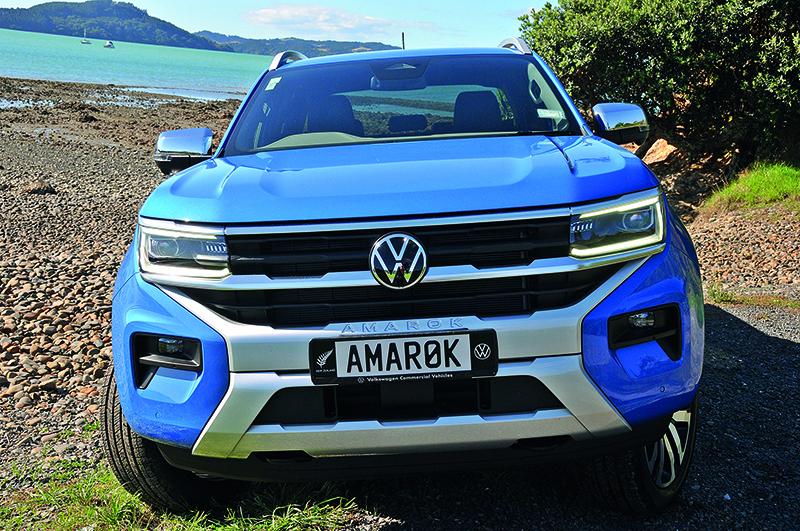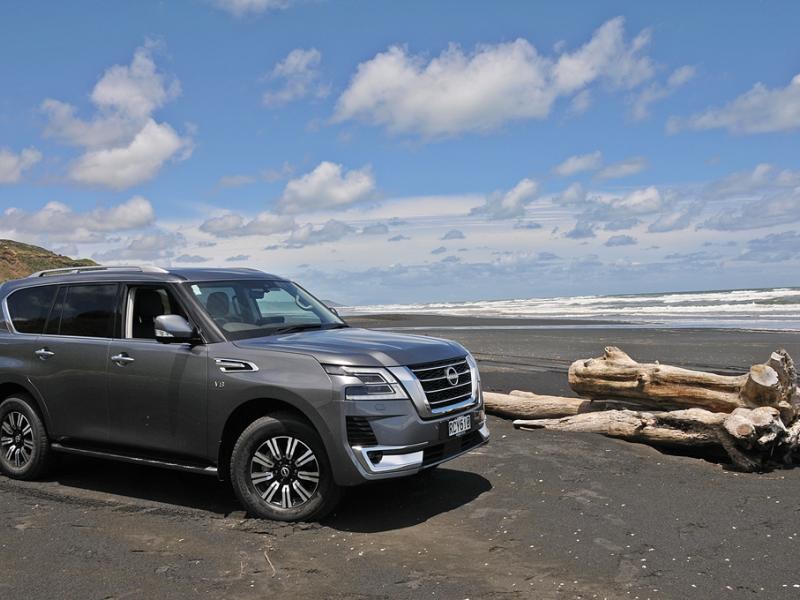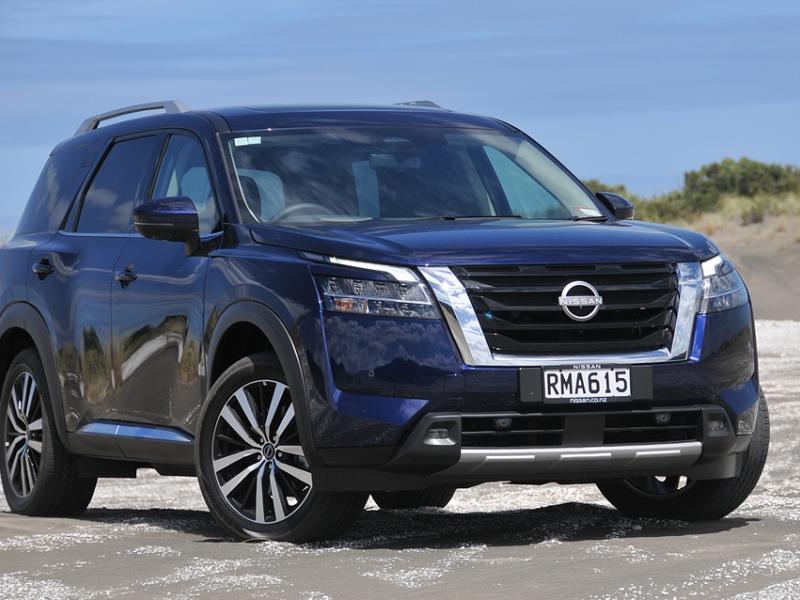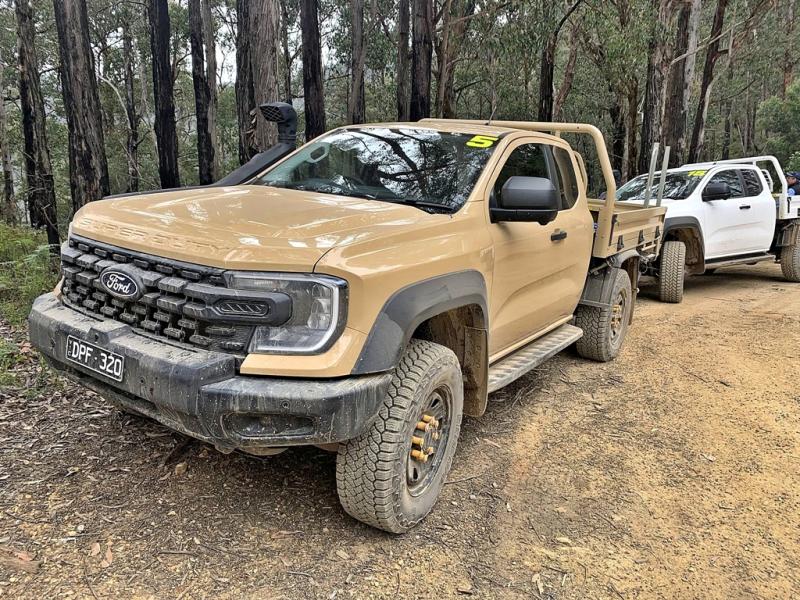With a swanky, high spec interior and a surprising level of refinement and driver assist technologies, the petrol-powered VW Amarok is an interesting proposition. It adds a completely new ‘vibe’ to the Amarok, and it’s hard to deny there are those who prefer petrol to diesel for their motoring. There’s a mindset shift required off-road, where a diesel’s torque ‘mountain’ can tend to flatter the driver while a petrol engine requires thoughtful use of the throttle. But the introduction of a 2.3-litre turbo petrol engine at the high-end level of Aventura does suggest there’s a definite leaning toward on-road and urban users.
Across the industry, safety tech has moved on a fair way. Gone are the days when an unsophisticated ‘lane keep’ function might thrust an unwary ute driver into the courier truck in the opposite lane. These days the assistance is subtle and gently eases the vehicle back on track. The various systems are also clever enough to stop intervening when the going turn to dirt.
The world is eyeing utes in a different way these days. New Zealand and Australia are ahead of the curve, with 4WD diesel-powered double cab 4WD utes topping outright sales sheets in both countries.
In Godzone, VW launched a well-considered range of diesel Amarok utes. The Life, Style, Panamericana and Aventura all address specific markets with superb luxury spec and two excellent engines: the turbo/biturbo four cylinder and the V6 turbodiesel.
So, what to make of a petrol-engined Aventura joining the four existing diesel offerings?
For starters, if ever there were a ute to convert a staunch city slicker, this is it. In top-spec Aventura guise, with a powertrain that might be expected in a towny SUV and equipped with a premium cabin, the petrol-powered Volkswagen is targeting a specific demographic.
This Amarok recognises that ute owners no longer fit into just one box – they have families, they spend time around town, they like the finer things and they are, sometimes, willing to splurge.
The question then must be: can the new petrol-powered Amarok stay true to its ute roots while successfully ensnaring a whole new demographic of buyers.
One of the key reasons for a petrol-powered Amarok is to give existing VW buyers a logical transition from its SUV offerings, like the Tiguan Allspace. In the ute market, a premium offering like this stands distinct from the almost non-existent petrol ute rivals, which have dwindled over recent years till Ford’s aggressive performance-oriented Ranger Raptor is possibly the sole rival.
However, if considering switching from SUV to dual-cab ute, make no mistake: the Amarok is a major step up in the size stakes. It is large. It measures around 1.8m tall at its highest point. It’s wider than the previous model, and longer too.
So does all that exterior size translate to more room in the cabin?
Yes.
It’s supremely, pleasingly ‘un-ute-like’ inside an Aventura, with tech, spec, layout and materials that all feel as though they belong in a premium SUV.
Volkswagen has worked hard on the interior where the digital displays, switchgear and steering wheel are all distinctly VW ‘flavour’. The seats are sumptuous buckets with robust bolstering that hold occupants in place in choppy going.
The leather seats offer power adjustment and heating (not so handy in a warm Auckland autumn, but roll on the misery of winter and they will be most welcome), while the 12-inch ‘portrait’ touchscreen draws the eye to the dash thanks to its crisp visuals. Both front seats are power adjustable.
The Aventura has an eight speaker Harman Kardon sound system.
Navigation is standard on every Amarok above the Life.
In terms of storage, there are creative solutions throughout the cabin, like the clever dual-opening glovebox, which offers compartments both at the top and bottom of the dash.
The cupholders are small but capable. Fine for Kiwis but possibly a challenge for American owners.
The centre console storage has a deceptively large lid, which opens to reveal a humble, yet helpful, storage compartment.
In the back seat of the Amarok, things are slightly more spacious than the previous model courtesy of the longer wheelbase. Legroom and headroom are adequate but not capacious, and the width of the rear bench will allow three adults to co-exist relatively comfortably.
The petrol Aventura steps up from 20-inch to 21-inch wheels and the tyres are enormous H/T treads: 275/45 Goodyear Wranglers, the widest in the range (Aventura V6 has 255/50 R20) and possibly the widest on any 4WD available in New Zealand.
That will slightly improve the Aventura’s already good approach (30 degree) and departure (26 degree) angles. Ground clearance too will be slightly up on the range’s 217mm.
The engine-transmission combination is well configured. That 2.3-litre turbo four produces 222kW at 5,900rpm and a very respectable 452Nm at 3,300rpm. Peak torque is more important than outright power and it is well situated halfway up the rev range. That’s definitely enough to move the Aventura’s 2.2 tonnes up a dirt track when required, or drag a big fizzboat up the ramp without complaint.
Official fuel consumption figure is 10.6l/100km. The truck was showing 12.5 when we picked it up and slowly improved to 10.8. All Amarok models comply with the EU5 emissions standard, and all have a five-star Euro-NCAP safety rating.
Coupling the engine to the ten-speed auto means it’s never missing in action and can be easily kept squarely in the middle of its torque ‘sweet spot’.
Directing the power and torque through the transfer case enables the driver to use 4WD on the open road with minimal fuel efficiency loss compared to the ‘default’ 2-hi.
There’s also a rear diff lock, engaged by a switch in the cab.
There are a range of drive modes, which are interesting to fiddle with, but frankly the vehicle is fine in 4A for most use, 4-Lo if things get messy and adding diff lock if it turns properly tricky.
Both V6 turbodiesel and this four-cylinder turbo share a class-leading braked towing capacity of 3500kg, though their payload figures are slightly different: 872kg with the petrol, 858kg with the diesel.
Driven, it’s an Amarok, of course. An Aventura, of course. But it’s a revelation on the open road in terms of cabin noise: there’s almost none. At 100km/h there’s no engine noise. Those big tyres send little if any road noise into the cabin. The only sound, in a crosswind, is a low murmur from the roof bars.
On the narrow thread of tarseal that heads south from Orere Point to Kaiaua, those big tyres make for sure-footed travel. Coming out of the village, we drop left off the main road onto the tiny sand, dirt and seashell tracks that link Kaiaua and the freedom camping area at Roy’s Rest. It’s packed with big caravans and motorhomes, people enjoying a break from city life. Mountainbikes and e-bikes are parked for the day, the barbecues are fired up and there’s a lot of gin and tonic recreation happening.
Further on, the wee tracks along the foreshore come and go, sandy and chock-full of seashells. The tide is coming in, and a couple of hopeful fishers are setting up their gear for a late afternoon session.
Despite the width of those tyres, the loose surface is never a worry, the truck is surefooted in 4A. This is simply where a careful foot on the throttle pays dividends. Knowing that the torque sweet spot is around 3,000rpm enables the driver to sit the tacho needle at that point. The transmission does the rest.
If necessary, manual shift mode lets the driver hold engine speed in a particular gear, though the shift mechanism is a little hard to find, being a pair of buttons on the side of the shifter itself. The ‘Up’ and ‘Down’ buttons are very small, and sit next to the one that selects manual mode so are hard to hit accurately without looking. It’s more designed for holding or selecting a low gear while off road rather than blipping down a couple of ratios to blast through a corner or two. For that, steering column paddle shifters are the best bet.
What else? Given this is really an engine variant model, the big differences are restricted to that turbo petrol engine and those 21X8.5” wheels and their huge tyres.
That engine definitely has some muscle. Giving it a boot down the onramp near Mangatawhiri had the ten-speed auto shifting, shifting and shifting again, the big truck rushing to open road speed halfway down the onramp.
The new petrol Aventura is priced equal to the V6 turbodiesel version, which means the choice is very much down to whether a petrol or diesel suits the buyer better.
In the end, though, this is not going to cannibalise sales of the diesel V6 Aventura, it is simply a worthy addition to the range, the turbo petrol engine creating a very different driving experience to the many diesel utes on our roads and in our driveways.







